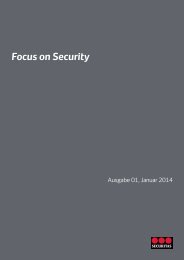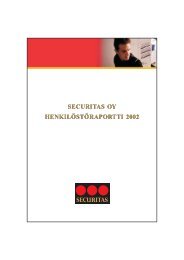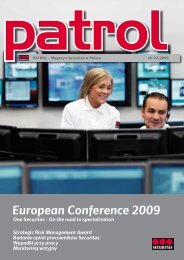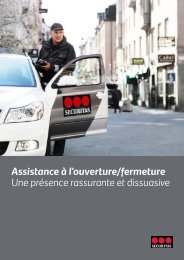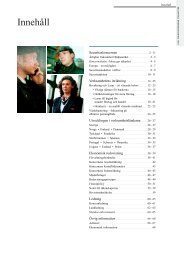SECURITAS AB Annual Report 2011
SECURITAS AB Annual Report 2011
SECURITAS AB Annual Report 2011
Create successful ePaper yourself
Turn your PDF publications into a flip-book with our unique Google optimized e-Paper software.
Notes<br />
Note 39. Accounting principles<br />
The Parent Company’s financial statements are prepared in accordance with<br />
the Swedish <strong>Annual</strong> Accounts Act and the Swedish financial <strong>Report</strong>ing<br />
Board’s standard RFR 2 Accounting for Legal Entities. The Parent Company<br />
thus follows the same accounting principles as the Group when relevant<br />
and except in the cases stated below. The differences that exist between<br />
the Parent Company’s and the Group’s accounting principles are a result of<br />
the restrictions that the Swedish <strong>Annual</strong> Accounts Act, the Swedish Act on<br />
Safeguarding of Pension Commitments and the options that RfR 2 allow<br />
for IFRS in the Parent Company.<br />
IFRS 3 Business combinations<br />
The Parent Company measures the acquisition cost as the sum of the acquisition-date<br />
fair values of assets transferred, liabilities incurred and all costs<br />
that are directly attributable to the acquisition. Contingent considerations<br />
are recognized as part of the acquisition cost if it is probable that they will be<br />
realized. The acquisition cost is adjusted in subsequent periods if the initial<br />
assessment needs to be revised.<br />
IAS 17 Leasing<br />
A complete implementation on legal entity level of accounting for finance<br />
leases is sometimes difficult to achieve since specific ordinances for the<br />
taxation based on such accounting are not available or are not complete.<br />
Finance leases can therefore on legal entity level be accounted for according<br />
to the requirements for operational leases. This limitation lacks practical<br />
implications since the Parent Company has not entered into any leasing<br />
agreements that could be classified as finance leases.<br />
IAS 18 Revenue<br />
Anticipated dividend from a subsidiary is recognized as income in the Parent<br />
Company in accordance with RFR 2 if the Parent Company has the exclusive<br />
right to decide the amount of the dividend from the subsidiary. The Parent<br />
Company must furthermore ensure that the dividend is in line with the subsidiary’s<br />
dividend capacity. Extra dividends are sometimes a complement to<br />
the anticipated dividend. If so, they are accounted for on a cash basis. Group<br />
contributions received by the Parent Company are equal to dividends and<br />
are thus recognized as financial income in the income statement.<br />
IAS 19 Employee benefits<br />
Accounting for defined benefit plans according to the Swedish Act on<br />
Safeguarding of Pension Commitments leads to differences between the<br />
accounting in the Parent Company and the Group. These differences have<br />
no material impact on the employee benefits relating to the employees of<br />
the Parent Company. Pension solutions either fall within the framework of<br />
the ITP–plan that is insured via Alecta, which is described in note 31, or in<br />
all material aspects consist of other defined contribution plans.<br />
IAS 21 Effects of changes in foreign exchange rates<br />
Paragraph 32 in IAS 21 states that exchange differences that form part of a<br />
reporting entity’s net investments in a foreign operation shall be recognized<br />
via the statement of income in the separate financial statements of the<br />
reporting entity. RFR 2 states that such exchange differences instead should<br />
be recognized directly in shareholders’ equity in accordance with paragraph<br />
14 d in chapter 4 of the Swedish <strong>Annual</strong> Accounts Act. Securitas <strong>AB</strong> follows<br />
RFR 2 and recognizes exchange differences that fulfills the criteria for net<br />
investment hedges, that is for which settlement is neither planned nor likely<br />
to occur in the foreseeable future, via the translation reserve in equity.<br />
<strong>Annual</strong> <strong>Report</strong><br />
Notes and comments to the Parent Company financial statements<br />
IAS 39 Financial instruments: Recognition and measurement<br />
The Parent Company follows IAS 39 with the exception of financial guarantees<br />
in relation to subsidiaries. For further information refer to the accounting<br />
principles adopted by the Group for recognition and measurement of<br />
financial instruments in note 2.<br />
Capital contributions<br />
Shareholders’ capital contributions are accounted for as an increase of the<br />
balance sheet item shares in subsidiaries. An assessment whether any<br />
impairment write-down is required in shares in subsidiaries is subsequently<br />
made.<br />
RFR 2 Group contributions paid<br />
The Swedish financial <strong>Report</strong>ing Board‘s statement ufR 2 Group contributions<br />
and capital contributions has been withdrawn and replaced by guidance<br />
in RFR 2 Accounting for Legal Entities. Securitas <strong>AB</strong> has consequently<br />
changed its accounting principle for group contributions paid. As of <strong>2011</strong>,<br />
they are accounted for on the line other financial income and expenses, net<br />
in the statement of income.<br />
The effect on the restated comparative year 2010 is that group contributions<br />
paid have impacted other financial income and expenses, net with<br />
MSEK -497.4. The tax effect on these group contributions are no longer<br />
accounted for in retained earnings. Instead the tax effect has impacted<br />
deferred taxes in the income statement with MSEK 130.8. Consequently,<br />
net income for the year 2010 has decreased by MSEK -366.6 while<br />
retained earnings have increased with the same amount. There is thus no<br />
change in total shareholders’ equity.<br />
for 2009 the change in accounting principle has impacted the line dividend<br />
with MSEK 500.2 and the line other financial income and expenses, net<br />
with MSEK -500.2. There has been no impact on total financial income and<br />
expenses, net income for the year 2009 or on retained earnings.<br />
Securitas share based incentive scheme<br />
In addition to the Group’s accounting principles for share-based payments<br />
(IFRS 2) as described in note 2 Accounting principles, the following has<br />
been applied in the Parent Company’s financial statements. The Parent<br />
Company has secured the delivery of shares according to Securitas share<br />
based incentive scheme by entering into a swap agreement with a third<br />
party regarding purchase of shares. To the extent that shares according to<br />
the swap agreement is subject to delivery to employees in other Group<br />
companies than the Parent Company, a liability to Group companies has<br />
been recorded in the Parent Company’s accounts. This liability is recorded<br />
at the value of the commitment that Securitas <strong>AB</strong> has to the subsidiaries to<br />
deliver shares, that is the number of shares to be delivered according to the<br />
swap agreement at the latest share price for Securitas <strong>AB</strong>’s series B share.<br />
Social security expenses are calculated based on the market value of the<br />
shares that potentially will be allocated. Fluctuations in the share price for<br />
these shares thus lead to changes in social security expenses that impact<br />
the Parent Company’s and Group’s income. This is the only impact on the<br />
Parent Company’s and Group’s income due to fluctuations in the share price<br />
for the shares that potentially will be allocated. This means that any possible<br />
increase or decrease of the liability to Group companies has not been<br />
accounted for in the Parent Company’s income statement.<br />
Securitas <strong>Annual</strong> <strong>Report</strong> <strong>2011</strong><br />
129





